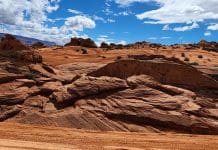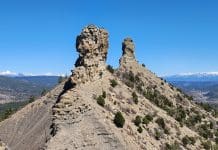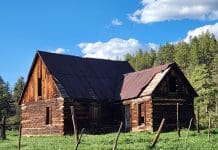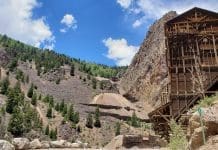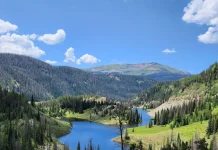The town of Bannack is a National Historic Landmark and a state park in Montana. The Bannack State Park is a well-preserved ghost town that you are able to explore.
It is a gold mine ghost town from the 1800s and early 1900s, left intact for visitors to peruse through the town as it stands before its last inhabitants moved out in the mid-1900s.
We stopped by while traveling in our RV in Montana.
Bannack State Park Ghost Town

Montana’s first major gold discovery was on July 28, 1862. By 1863, the population of Bannack had swelled to 3,000 people in this remote area of Montana.

It was a true “Old West” town, complete with a saloon, corrupt sheriff, pious churchgoers, jail, and all the mix that make for interesting stories about the town’s history.

But by the time the town went bust, the over 50 buildings on Bannack’s Main Street were left abandoned, just as they are today.
The historic log buildings help show what life was like in Montana’s early years, when it served as the first capital of the Montana Territory, and not yet a state of the United States.
The town is left exactly as it was (and revered as the best preserved of the Montana ghost towns), just as it was during the gold mine rush that brought it to life.

Bannack is a surreal place to visit, as the town is in relatively good shape, but the town dwellers have long moved on.
It helps tell the story of what life was like for settlers in early mining towns that came about as part of a gold rush.
Anyone with even a passing interest in American history, western movies, or life in the wild west will likely enjoy a day spent wandering through the many buildings remaining in Bannack.

Bannack State Park Visitor Center
Be sure to stop at the visitor center to pay your entrance fee and view the books, pictures, movies, and other items available that provide background information on the town.
Entry is free for Montana residents or $6 per vehicle for out-of-state visitors (as of September 2018).

You should also be sure to pick up the Bannack guidebook for $2.00.
This handy guidebook is about 20 pages long and features details on each of the buildings and artifacts in the ghost town.
It has interesting details about life during Bannack’s prime mining days that help put life in the town in context.
The guidebook has numbers for each building which are also carved into the boardwalk in front of the corresponding building in the town.
Each corresponding number in the guidebook tells the story of that particular building, who lived there, and other interesting facts.

For example, several of the buildings’ high-level information is provided below with photos of the houses, stores, hotels, jails, and other types of town dwellings to give an idea of what you’ll see in the ghost town of Bannack.
Visitors are able to go inside most of the buildings in Bannack for a first-hand view.
Ghost Town Buildings
The Hotel Meade
The Hotel Meade started its life as the Beaverhead County Courthouse when it was built in 1875 for $14,000.
In 1891 it was turned into an upscale hotel which was operated until the 1940s.

Inside there’s a large curved staircase up to the second level where there were additional hotel guest rooms.

Looking out the window of the staircase in the hotel provides a picturesque viewpoint of the ghost town.

You can also see where the large kitchen once was, including an old stove used for cooking hotel meals.

Details about the old lathe and plaster walls can be seen as well throughout the grand old hotel building.

The old room numbers are still visible on the hotel room doors.

City Drug Store at Bannack State Park
The City Drug Store building was used for many different purposes over the years in Bannack.
It served as a drug store, a general store, an assay office, and even as a school for a temporary time period.


Xavier Renois Cabin
This cabin was built using simple hand tools in 1864 by a French Canadian man named Xavier Renois.
He was a carpenter by trade whose cabin exemplifies the fine craftsmanship of the time period.

The cabin was constructed using hand hewn logs, double dovetail log notching, and wooden peg construction.
All workmanship was done by hand.

Masonic Lodge and Schoolhouse Building
The Masonic Lodge and schoolhouse building was built for the Free Masonry fraternity group and as a school building for the community in 1874.
The Bannack Historic Lodge, number 3-7-77, is still active and its members help preserve the building.
The upstairs of the building housed the Masonry group and it is still furnished in period style.


The downstairs of the building was used as the schoolhouse for Bannack.
One classroom and one teacher served all the students in the town.

The chalkboard illustrates the rules for teachers in 1915:
- You will not marry.
- You will not keep company with men.
- You must be home between the hours of 8 PM and 6 AM.
- You may not loiter downtown.
- (indecipherable)
- You may not ride in a carriage or automobile with a man unless he is your father or brother.
- You may not smoke cigarettes.
- You may not wear bright colors or dye your hair.
- You must wear at least 2 petticoats.
- Your dress may be no shorter than 2 inches above your ankle.
- You must keep the school room neat.


These probably wouldn’t be too well accepted today!
Bannack Jails
The first jail in Bannack was built in 1863, which was the first jail built in the area later to become the Montana Territory.
Prisoners had a clear view of the gallows out their window to remind them what awaited them if things didn’t turn around in their favor.


Methodist Church
The Methodist Chuck in Bannack was built in 1877.
It was served by traveling ministers during the time the town operated as a mining town.
Many of the “respectable” women during the time wrote letters and in their diaries complaining of a lack of a church in Bannack until this one was built.


Gibson House in the Bannack Ghost Town
The Gibson House had previously served as a blacksmith shop before becoming a family home.
Inside on the walls you’ll find branding iron markings on the interior room walls.


The house’s kitchen still has the old stove used to cook the family’s meals.

Traditional Log Cabin Construction
One aspect of visiting Bannack that is interesting is that you can go into most of the buildings and see how they were built.
They had one resident living in the town up until 1968, but most of the buildings were constructed way before that and most residents were long gone by 1968.


You can see the log construction, including actual tree trunks used as ceiling rafters.

You can also see hand hewn logs used as the walls of some of the cabins.
These logs all show the signs of rough cuts with saw blades.

Mining Artifacts in Bannack State Park
Bannack began with a gold rush in 1862 when gold was discovered along the banks of the Grasshopper Creek.
The town went through several mining phases until WWII when all non-essential mining operations were prohibited.
Mining equipment from the various phases of Bannack’s mining history are on display throughout the old mining ghost town.


Getting to Bannack State Park
Bannack State Park is located near the town of Dillon, Montana. The address is 721 Bannack Rd, Dillon, Montana 59725.
One word of caution, be careful about using the search results in Google for “Bannack State Park” as it might take you to a neighborhood in Dillon, Montana, rather than the site of the state park.
Use the Google Maps location from the map above.
RV Parking
If you plan to visit Bannack while travelling in an RV, like we did, there is plenty of RV parking available at in the parking lot near the visitor center.

We found plenty of parking for our Airstream travel trailer and truck in the parking lot near the visitor center.

Pet Kennels
If you’re traveling with Fido, you can bring him into the ghost town (so long as you pick up after him) or you can avail of these pet kennels located in the parking lot area.
If your dog is afraid of ghosts, then the pet kennel might be a good idea.
To use the pet kennels, register your pet at the visitor center.

Bannack State Park Campgrounds
If you’re interested in camping, Bannack State Park has two campgrounds for tent and RV campers: the Vigilante campground and the Road Agent campground.
These are located in a pretty area with a creek running through it right down the street from the old mining town.
There are a total of 24 campsites, which can be reserved on the Reserve America website.
Eight of the campsites are available on a first-come, first-served basis. The campgrounds in Bannack also have one teepee hut that can be reserved.
The campsites are all dry camping with no hookups, i.e. no water, sewer, or electrical connections for your RV. You’ll need to bring in whatever you need to camp.
We didn’t stay in a campground at Bannack State Park, but opted to boondock about 20 miles away at the West Cameahwait Campground at the Clark Canyon Reservoir.

